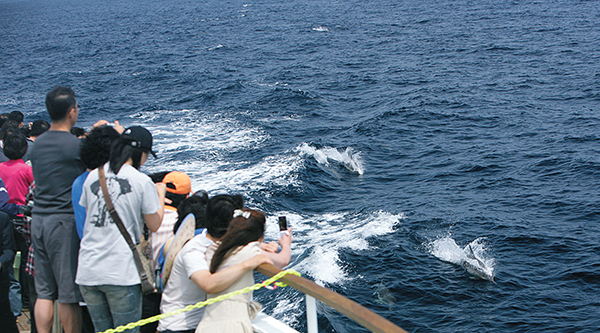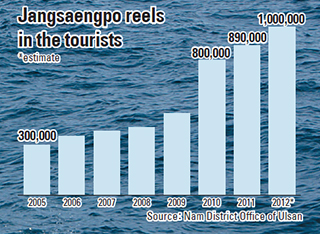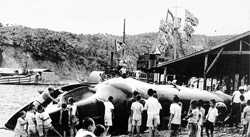Tourism brings former whaling village back to life

Tourists watch a pod of whales in the sea near Ulsan. Provided by Nam District Office of Ulsan
ULSAN - It’s a scene out of “Moby-Dick.”
Whalers sharpen 1-meter (3.2-feet) long whaling harpoons with cigarettes hanging from their mouths aboard dozens of 50-ton whaling ships anchored by the Jangsaengpo Port in southeast Ulsan.
After 3 to 4 hours at sea, the sailors arrive back at port with two or three 18-meter (59-foot) right whales, an endangered baleen whale species.
The whales’ weight is measured by retailers under the whaling association who pay over 10 million won ($9,168), an amount worth about 100 billion won today.
At home, these sailors boast black-and-white television sets, rare in those days, telephones and Japan-imported wristwatches.
Such was the life of Ulsan whalers in the 1970s.
Lee Man-woo, 54, head of a whale culture preservation association, said, “Like the saying, ‘even the neighborhood dog walks around with 10,000 won in his mouth,’ Jangsaengpo was that well-off and crowded with people back then.”
“Whalers at that time earned a monthly income of what is worth 10 million won nowadays,” Lee added.

It took three decades for the Jangsaengpo revitalization to come about as Ulsan’s Nam District pumped in 6.5 billion won to transform the ghost port into a center of whale tourism.
The four-story Jangsaengpo Whale Museum opened in May 2005. It displays artifacts and photographs from whaling, including the skeleton of a 12.4-meter killer whale.

1970년대 울산 장생포항에서 선원들이 붙잡은 고래를 해체하고 있다. [사진 울산 남구]
Starting in 2009, visitors for the first time in the country’s history could go whale-watching in the Ulsan waters on a 262-ton vessel.
Tourism officials say a whale can be spotted on one out of four trips.
The city further invested 1 billion won to hold the large-scale annual Ulsan Whale Festival every April.
And the results began to show. Prior to the efforts, there were rarely any whale tourists.
The number grew to 300,000 in 2005, then 400,000 in 2008, and doubled to 890,000 visitors, including tourists from Japan and China, last year.
Likewise, the whale tourism industry grew six-fold from 1 billion won in 2005 to 6.6 billion won in 2011. In 2008, the Ministry of Knowledge Economy declared Jangsaengpo an exclusive whale zone.
The once-abandoned Jangsaengpo port now has some 240 stores, including whale-themed restaurants, souvenir shops and even bakeries, and 1,157 residents.
Kim Bok-geun, in charge of whale tourism at the Nam District Office, said, “The success of Jangsaengpo is the ‘whale-themed’ tourist attractions.
“Building whale-related facilities as the only whale center in the country worked out well.”
The city expects whale tourism to continue to boom. The district will spend another 15.8 billion won on building a 164-square-meter boardwalk along the port.
By Kim Yun-ho [sarahkim@joongang.co.kr]










with the Korea JoongAng Daily
To write comments, please log in to one of the accounts.
Standards Board Policy (0/250자)